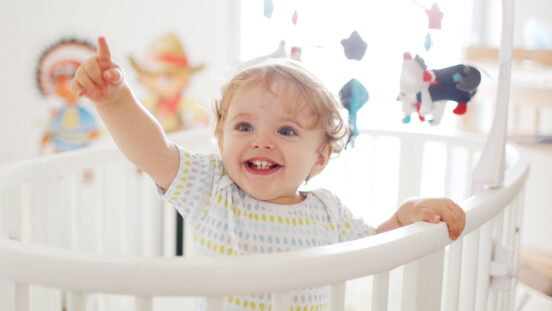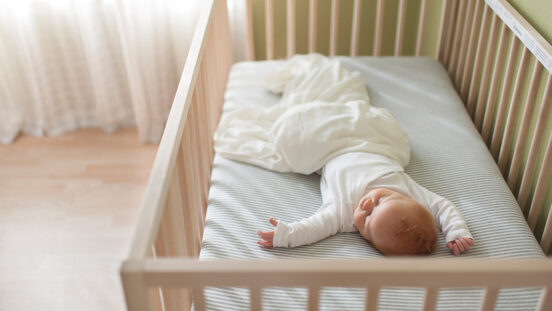How to safely co-sleep with your baby to reduce the chances of SIDS
Understanding the risks and benefits of co-sleeping is essential for all new parents wanting to make an informed decision.
Co-sleeping with your baby can be a wonderful bonding experience that helps you and your baby get some much-needed rest. But co-sleeping also has some serious risks.
Mother & Baby is careful not to recommend that babies sleep in an environment that could cause them harm, and under some circumstances co-sleeping can be risky for your baby's safety.
So how can you co-sleep without risking your baby's health and safety? Let us explain some important details.
Risks of co-sleeping
SIDS and Kids Australia explain that co-sleeping or bed-sharing with a baby can increase the risk of Sudden Unexpected Death in Infancy (SUDI), including Sudden Infant Death Syndrome (SIDS) and fatal sleep accidents.
SIDS and Kids remind parents that co-sleeping with your baby is risky under the following circumstances:
- Where babies are less than three months of age
- Where babies were born preterm or small for their age
- Where the baby so-sleeps with a smoker
- Where the parent is under the influence of alcohol
- Where the parent is under the influence of drugs (prescription or illegal) that cause sedation
- Where the parent is overly tired (difficult to arouse)
- Where the parent is obese
- Where there is adult bedding, doonas or pillows that may cover the baby
- Where the baby can be trapped between the wall and bed, can fall out of bed, or could be rolled on
- Where babies are sharing beds with other children or pets
- Where the baby is placed to sleep on a sofa, armchair, beanbag, waterbed or sagging mattress alone or with another person

Is it possible to co-sleep without risking your baby's health and safety?
What types of co-sleeping are not safe?
– Sofa sharing
Sleeping with your baby on a sofa or couch is not recommended as a safe sleeping environment for your baby and has been found in studies to carry a high risk of death or accident.
"The baby may become wedged into cushions or the back of the sofa," explains SIDS and Kids.
– Sleeping on a parent’s chest
While babies can be easily settled on their parents' chests it is not recommended for parents to fall asleep while their babies rest in this position.
This is due to a baby's airway being at risk of becoming obstructed by clothing, their parent's body, or by their chin resting on their own chest.
– Sleeping in an adult’s bed
SIDS and Kids are quick to point out that adult beds and bedding are not designed for the needs of a baby.
According to multiple case studies, a baby sleeping in bed with their parent puts them at an increased risk of being rolled on to, being wedged between the mattress and another object (e.g. a wall), being entrapped in bed railings, or being suffocated by pillows or blankets.

Research has found that there are some benefits to co-sleeping.
Are there any benefits of co-sleeping?
While SIDS and Kids eagerly remind parents of the high risks of sharing their sleep environment with their babies, they also acknowledge that many studies have found that co-sleeping has some benefits.
These benefits include:
- More successful breastfeeding relationships
- Improved sleep for mothers
- Increased baby sleep arousal, which reduces the risks of SIDS
- Enhanced bond between mums and babies
- Less crying, unsettled periods and stress for babies
- Babies grow into children and young adults with higher self-esteem, better social skills, and less psychiatric problems
- Mums develop protective sleep behaviours (e.g. when sleeping with her baby a mum typically faces towards her baby and positions herself so that her baby cannot be rolled on to, or slip underneath bedding).

SIDS and Kids recommends that you ask yourself what you think is best for you and your baby.
So should I co-sleep with my baby?
With considerable risks for sleeping with your baby, but also benefits, it can be confusing to know what choice to make.
SIDS and Kids recommends that you ask yourself what you think is best for you and your baby.
"Before you share a sleep surface with your baby, consider whether you are happy it is safe for YOUR baby," says the experts in safe sleeping.
They also recommend a risk-minimisation approach to co-sleeping, to make sure your co-sleeping environment is as safe as possible.
How to reduce the risks when co-sleeping
SIDS and Kids suggest the follow strategies to improve your sleep environment when co-sleeping with your baby:
DO'S
- Do place your baby on their back to sleep and never on their tummy or side.
- Do make sure the mattress is firm and clean.
- Do make sure that bedding cannot cover your baby's face.
- Do use lightweight blankets.
- Do keep any pillows, doonas or soft items well away from your baby.
- Do make sure there is nothing soft underneath your baby.
- Do place your baby to sleep beside you and not in between and and your partner
- Do use an infant sleeping bag so your baby does not share your adult bedding.
- Do tie-up very long hair to prevent entanglement.
- Do remove teething necklaces prior to sleep.
DON'TS
- Don't wrap or swaddle your baby.
- Don't let your baby sleep too close to the edge of the bed where they can fall off.
- Don't put pillows next to your baby to prevent them rolling off the bed. A safer alternative is to place the adult mattress on the floor.
- Don't push your bed up against the wall.
- Don't leave your baby unattended on a sofa or bed.
For more information on co-sleeping and safe sleeping for babies visit SIDS and Kids to read their guidelines for sharing a sleep surface with a baby.




